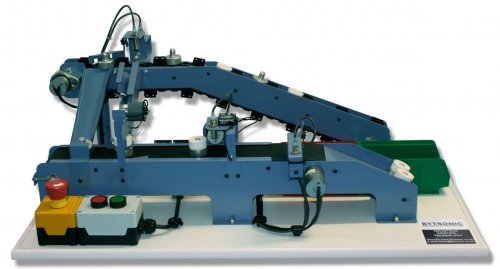Product Description
The Industrial Control Technology (ICT3) is a representation of an industrial assembly system that allows the study of control methods used in product assembly and inspection in a manufacturing process. Various industrial sensors and the methods, in which they can be used, are studied. The Sensors and actuators are used to sort components, assemble them and test for correct assembly followed by acceptance or rejection. The unit can be controlled from a PLC using the 24v dc I/O interface.
The unit assembles two components a plastic ring and an aluminium peg. A chain conveyor processes the components through the sort area; the plastic rings and aluminium pegs proceed down a ring and peg chute and are then assembled on the belt conveyor. At the assembly check area components are inspected for correct assembly and when the components reach the final area, if correctly assembled they proceed to the acceptance area, faulty assemblies are rejected into a reject bin. Correct programming of the controller (PLC) must be achieved to ensure incorrect components are not sent to the final assembly area.
Once the program has been written and the system is working correctly, various faults can be applied using the fault insertions switches, providing diagnostic solving issues. LED’s on the sensors provide a visual indication of the operational status of the sensors. The sort and reject solenoids are fitted with sensors to monitor the operation of the solenoids and to ensure the operation has been correctly performed
Experiments
- Sorting routine
- Closed loop solenoid control
- Queue counting
- Operation timing
- Plastic ring detection/rejection
- Metal peg detection/rejection
- Component acceptance and rejection
- Component queue handling
- Complete system control
- Start / Stop switches


